
Apparently, Röhm’s concept of honor allowed him to break promises made publicly (and supposedly solemnly) to his boss and formally the closest comrade-in-arms. It was clear that he still clung to his vision of a new German army with the SA at its core (the pledge to Hitler, the government and the Reichswehr be damned).
To add insult to injury (and to make things innumerably worse for him), Röhm was the only Nazi leader who publicly demonstrated his independence from Adolf Hitler thus publicly rejecting the all-important for the latter (and for most of his followers) Führerprinzip.
As well as the open contempt for the party (and state) bureaucracy that Hitler view as a vitally important tool in his reengineering project (and subsequent operation of his Führerstaat).
To make things even worse, Röhm’s SA was not only the most numerically strong paramilitary force (boasting 3,000,000+ members), but it was potentially far better armed than even the Army (let alone police).
Röhm was an expert in hiding even the heavy artillery from the Allied investigators so God only knew which kind of military hardware he was able to issue to his stormtroopers if (or when) needed.
Hence, it was not just Reichswehr and conservatives that viewed the SA as an existential threat. Several of Hitler’s closed lieutenants feared Röhm’s growing power, violence and restlessness – as did Hitler himself.
However, there were others (Hitler’s opponents and competitors, to be more precise) who were willing to go to really great lengths to use the SA (and Röhm personally) to achieve their highly ambitious political objectives.
One of them was, not surprisingly, General der Infanterie (equivalent to three-star general in the US Army) Kurt von Schleicher – a former Reich Chancellor who was forced out of politics after the Nazis seized power in Germany in 1933.
He apparently plotted to convince Reich President von Hindenburg to radically restructure Hitler’s cabinet replacing the Vice Chancellor von Papen with von Schleicher (who in time would replace Hitler as Reich Chancellor). And… replace von Blomberg as Defense Minister with… Ernst Röhm.
Given that von Hindenburg could not stand Röhm (hated his guts, actually), it was a very, very stupid idea. And the decision by some of Schleicher’s followers such as General Ferdinand von Bredow and Werner von Alvensleben to pass along lists of a new Hitler Cabinet (where the arch-enemy of the latter Gregor Strasser was listed as a new Minister of National Economy) was ten times more stupid.
Not surprisingly, von Bredow became one of the victims of Operation Hummingbird. Von Alvensleben was spared for some unknown reason but spent several months in prison and then was confined to his native village of Neugattersleben until it was liberated by the Allies in 1945.
Security of the plot was non-existent and Heydrich’s SD worked very efficiently so Adolf Hitler received the copy of this list in no time. Although initially he was reluctant to go after Röhm (given the military power of the SA), this was the threat that could not have been ignored. Actually, it was more than just a threat – it had look, feel and threat of a full-blown political crisis in the making.
However, the first to take concrete tangible action were (not surprisingly), Hermann Göring transferred control of the Gestapo to Himmler, who, promptly named his deputy Reinhard Heydrich (head of the Party intelligence service) chief of the Gestapo.
Having their own vested interest in doing away with Röhm and severely limiting the power of the SA (both Himmler and Heydrich wanted to make the SS the only Nazi paramilitary force), they immediately started working on a “hit list”.
The list was compiled in no time and predictably shared with top Reichswehr commanders (no mass murder could have been committed in Germany at that time without the consent of the Army).
At the end of May of 1934 two former Chancellors, Heinrich Brüning and Kurt von Schleicher, received warnings from their friends in the Reichswehr that their lives were in danger and they should immediately leave Germany at once.
Brüning was the smart one so he fled to the Netherlands right then and there (in the very beginning of June). Schleicher was the stupid one so he dismissed the tip-off as a “bad joke”. Unfortunately for him, it was no joke – and he paid for his stupidity and arrogance with his life (and the life of his wife).
By the beginning of June of 1934 everything was set and all that was needed to launch Operation Hummingbird was the green light from Hitler. However, Der Führer was still undecided and uncertain about just what precisely he wanted to do, when and how when he left for Venice to meet Benito Mussolini on June 15.
Before Hitler left, and at the request of Presidential State Secretary Otto Meißner (who most likely acted on orders from his boss von Hindenburg), Foreign Minister Baron Konstantin von Neurath ordered the German Ambassador to Italy Ulrich von Hassell to ask Mussolini on his behalf (von Neurath was a former ambassador to Italy, and knew Mussolini well) to tell Hitler that the SA was blackening Germany’s good name. Obviously, Hitler was not informed about this request.
Mussolini who had his own reasons to protect the image of Nazi Germany abroad (he wanted to enter into a strategic partnership with Hitler) readily agreed. During the summit in Venice, Mussolini upbraided Hitler for tolerating the violence, hooliganism, and homosexuality of the SA, which Mussolini stated were ruining Hitler’s good reputation all over the world. While Mussolini’s criticism did not win Hitler over to acting against the SA, it helped push him in that direction.
Another push came (not surprisingly) from Vice Chancellor Franz von Papen (a confidant of the ailing Hindenburg, among other things). On June 17, 1934, he delivered a now-famous speech at Marburg University warning of the threat of a “second revolution” in Germany. in other words, of a takeover of the government (and of the country) by the SA – with catastrophic consequences for “all of the above”.
According to his memoirs, von Papen, a conservative Catholic aristocrat with close ties to army and big business, privately threatened to resign if Hitler did not act against the stormtroopers – and do it quickly, decisively and ruthlessly.
While von Papen’s resignation as vice-chancellor would not have threatened Hitler’s position, it would have nonetheless been an embarrassing display of independence by a leading conservative political partner of the Nazis.
But the final push that doomed the brownshirts came from Hindenburg himself. The Reich President essentially issued an ultimatum to his Reich Chancellor: either the latter takes care of the “SA Problem”, or von Hindenburg will do it himself – by dismissing Hitler from his post, declaring the martial law and handing the full executive power in Germany to Reichswehr.
Hitler had hesitated for months in moving against Röhm, in part due to Röhm’s visibility as the leader of a well-armed national militia with millions of members and in part because the SA made up a large part of Nazism’s most devoted followers.
However, this ultimatum forced him to act because von Hindenburg was the only person in Germany with the authority and the ability to depose the Nazi regime (and Adolf Hitler himself).
So the latter had no other choice but to leave for presidential residence in Neudeck (now a village in northern Poland). Defense Minister von Blomberg, who had been present at a meeting with the Reich President, used this rare opportunity to uncharacteristically reproach Hitler for not having moved against Röhm earlier and thus wasting so much valuable time.
The combined pressure from Hindenburg and Blomberg finally forced Hitler to go against Röhm and the SA in full force. However, in the end Der Führer outsmarted and outfoxed both of them (as well as other conservative and Reichswehr generals).
He left Neudeck with the firm intention of doing away with all his opponents – not only the SA leaders, but also with the conservatives, political Catholics and his personal enemies (first and foremost, with those who wronged him).
Not surprisingly, both Himmler and Göring welcomed Hitler’s decision, since both had much to gain by Röhm’s downfall – the independence of the SS for Himmler, and the removal of threat to the Prussian police (and the law and order in Prussia in general) for Göring.
It as no surprise either that Adolf Hitler entrusted the two abovementioned individuals (his closest lieutenants) with preparation and execution of what will ultimately become Operation Hummingbird (now commonly known as The Night of the Long Knives).
In preparation for the mass murder (let’s call a spade a spade), Himmler and Heydrich, chief of the SD and Gestapo, manufactured convincing evidence that ostensibly proved that Röhm had been paid 12 million Reichsmark by France (the known arch-enemy of Germany) to use the SA to overthrow Hitler’s government.
Which according to a criminal law of any country was high treason – plain and simple. And at that time, the customary punishment for high treason was death. Leading officers in the SS were shown this “evidence” on June 24. It did not make any difference, however because just about every member of the SS was eager to get rid of their rivals from the SS and tom achieve much-coveted and much-valued independence.
Acting on Hitler’s orders, Göring, Himmler, Heydrich, and Victor Lutze (a fiercely loyal to Adolf Hitler SA-Obergruppenführer, police president of Hanover and its provincial governor and state counselor) put together a list of individuals (SA leaders, conservatives, Catholic politicians, personal enemies of Adolf Hitler) to be physically liquidated.
Interestingly enough, one of the men Göring recruited to assist him in this endeavor was one Willi Lehmann, an SS officer and Gestapo official… and the only known Soviet spy in the Nazi security system.
There was, however, one more issue to take care of – obtaining the explicit support of the Reichswehr. Not surprisingly, it was obtained easily and effortlessly as the Reichswehr brass were more than anxious to get rid of the troublesome SA leaders.
On June 25th, Generaloberst (four-star general) Werner von Fritsch (then commander-in-chief of the German Army) placed the Reichswehr on the highest level of alert – to support the SS death squads if something goes seriously wrong with Operation Hummingbird.
On June 27th, Defense Minister von Blomberg and General Walther von Reichenau (then the Reichswehr liaison to the Nazi party, expelled Ernst Röhm from the German Officers’ League, showing loud and clear where their loyalties were.
On June 28th, Hitler went to Essen to attend a wedding celebration and reception; from there he called Röhm’s adjutant at Bad Wiessee (a Bavarian spa town about 50km from Munich) and ordered SA leaders to meet with him on June 30 at 11pm. It was a trap which the SA totally and completely failed to see.
On June 29th, a signed article in Völkischer Beobachter by Blomberg appeared in which Blomberg stated with great fervor (which was no surprise given von Blomberg admiration for Hitler) that the Reichswehr fully, totally and completely stood behind Adolf Hitler.
The massacre started in the morning of the next day.
 November 4th, 1921. The Sturmabteilung – Nazi Party original paramilitary wing – is formed. Contrary to a very popular misconception, NSDAP was not the only political party in Weimar Germany that had a paramilitary wing (i.e. its own army). Both of its principal rivals (the centrists were all but eliminated after the Kapp Putsch) – the KPD and the SPD had paramilitary organizations in their structures.
November 4th, 1921. The Sturmabteilung – Nazi Party original paramilitary wing – is formed. Contrary to a very popular misconception, NSDAP was not the only political party in Weimar Germany that had a paramilitary wing (i.e. its own army). Both of its principal rivals (the centrists were all but eliminated after the Kapp Putsch) – the KPD and the SPD had paramilitary organizations in their structures.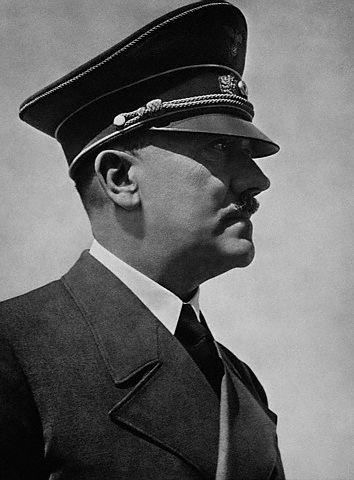 By physically eliminating the leaders of the remaining opposition (after Communists, Social Democrats and many other political opponents were arrested and interned in concentration camps), Operation Hummingbird solved a crucial political problem of the Nazi regime (and of Hitler personally). And thus cleared the way for the radical reengineering of Germany.
By physically eliminating the leaders of the remaining opposition (after Communists, Social Democrats and many other political opponents were arrested and interned in concentration camps), Operation Hummingbird solved a crucial political problem of the Nazi regime (and of Hitler personally). And thus cleared the way for the radical reengineering of Germany.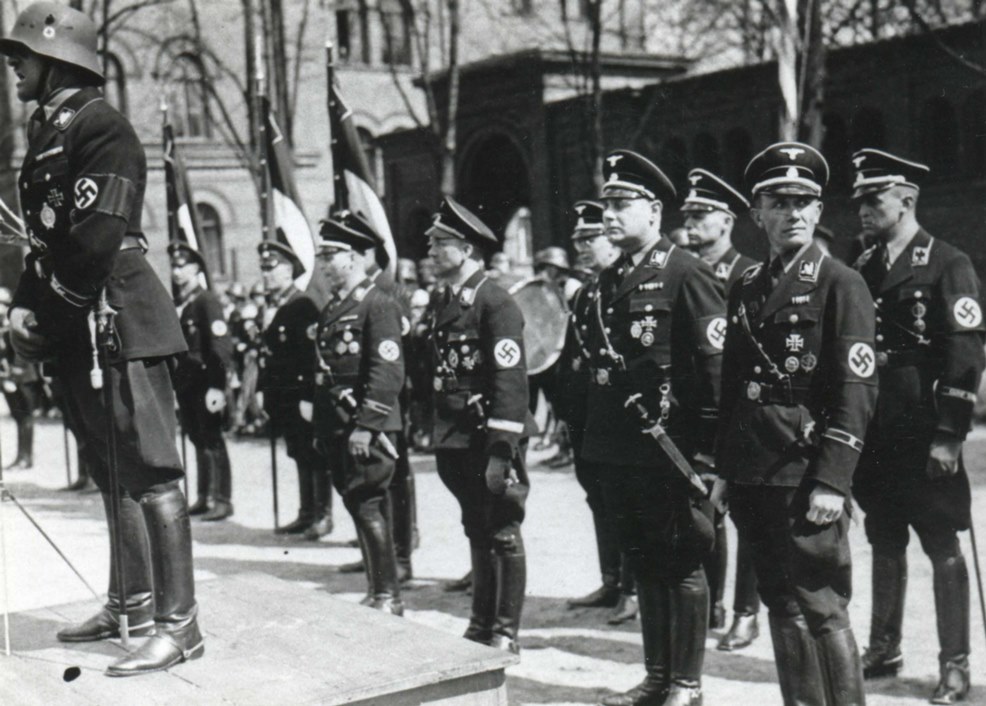


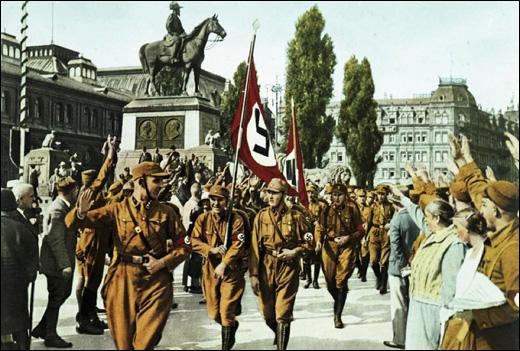

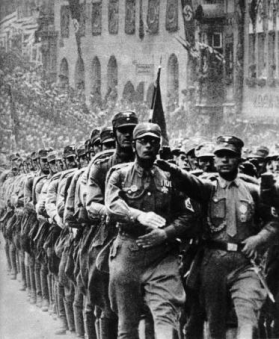 By itself, elimination of political opposition by the leaders of the country committed to making a Quantensprung of the magnitude that the Third Reich had to make, is not a crime.
By itself, elimination of political opposition by the leaders of the country committed to making a Quantensprung of the magnitude that the Third Reich had to make, is not a crime.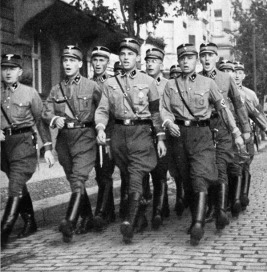 Hitler called his paramilitaries Sturmabteilung (SA) after the elite (and highly successful) specialized assault troops (“stormtroops”) of Imperial Germany in World War I who used so-called “Hutier infiltration tactics”.
Hitler called his paramilitaries Sturmabteilung (SA) after the elite (and highly successful) specialized assault troops (“stormtroops”) of Imperial Germany in World War I who used so-called “Hutier infiltration tactics”.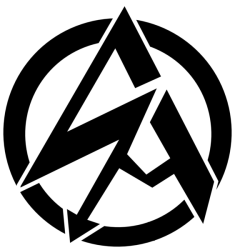 Adolf Hitler needed a paramilitary wing for his party for a number of reasons. First and foremost, he needed his own (i.e., loyal only to him personally) paramilitary force to successfully execute the coup without having to rely on Bavarian Army – Reichswehr units, Freikorps and the Civil Guard (their neutrality would be sufficient). The failed Beer Hall putsch proved it beyond the reasonable doubt.
Adolf Hitler needed a paramilitary wing for his party for a number of reasons. First and foremost, he needed his own (i.e., loyal only to him personally) paramilitary force to successfully execute the coup without having to rely on Bavarian Army – Reichswehr units, Freikorps and the Civil Guard (their neutrality would be sufficient). The failed Beer Hall putsch proved it beyond the reasonable doubt.